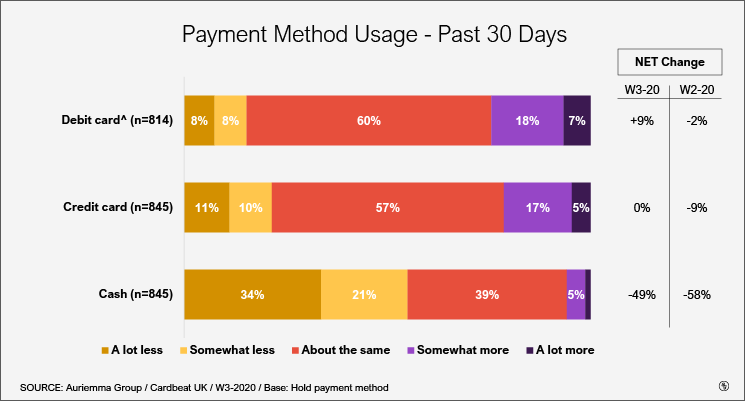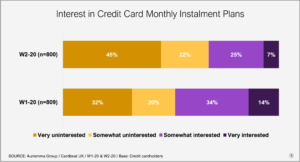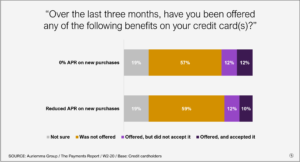(New York, NY) COVID-19 changed consumer purchasing behavior in the short-term, but will changes be long-lasting or temporary? It is a question often asked within the payments industry, and one that Auriemma Group’s research has been asking consumers for months. Auriemma’s latest Mobile Pay Tracker study (fielded April-May 2020) uncovered that the answer may be a little bit of both—purchase frequency could level, but preferred methods, channels, and services may shift to create a new normal going forward.
1. Shopping habits will likely level out, but methods may change
In the early days of COVID-19 consumer spend was reoriented to household purchases (e.g., food, cleaning supplies). While specific categories of purchases saw notable spikes, spend overall declined. Auriemma’s research found that in April and May two-thirds (65%) of cardholders said they were spending less over the past 30 days than they would have before COVID-19. When asked about the next 30 days, however, this figure drops to 44%, and a similar proportion (42%) expect their spend to return to pre-COVID-19 levels by that point.
Although spend may return to normal, there may be a new normal for how consumers make payments. More consumers are trialing contactless and mobile payments than ever before, and some are shifting their purchase channel preferences. For example, consumers have historically preferred in-store shopping for groceries, and while most still do, a notable 31% now say they prefer using digital channels (i.e., websites, mobile apps) to make grocery purchases.
“COVID-19 has given consumers strong incentive to try new payment methods and purchase channels,” says Jaclyn Holmes, Director of Research at Auriemma Group. “The disruption it has caused may be the catalyst that propels more innovative shopping and payment experiences moving forward.”
2. COVID-19 has not only changed how consumers shop, but also where
Staple household items were in high-demand at the start of COVID-19, and the need for those items trumped merchant and brand loyalty. Many consumers said stores they regularly shop at were out of many items (76%), that they needed to switch from their preferred brand to purchase an item they needed (67%), and that they have visited stores they don’t normally shop at to find what they need (35%).
This sentiment extends to the online shopping experience, with 40% of those shoppers saying they have tried shopping with new merchants or websites since the COVID-19 outbreak. Overall, COVID-19 has motivated consumers to try different merchants, items, and experiences. Nearly two-thirds (64%) of consumers say they are willing to try new ways to shop, including using apps and curbside pick-up.
“Brand loyalty is often a strong purchase motivator, both when purchasing products and selecting a merchant,” says Holmes. “In recent months, many consumers have tried new merchants and products out of necessity. While some will understandably revert back to their preferred brands, some have expressed they’ve been pleasantly surprised by these alternatives and will continue to utilize or purchase from them looking ahead..”
3. Some industries and products will thrive, while others will struggle
With consumers staying and/or working from home, there were many services that gained popularity. Unsurprisingly, consumers reported increased usage of video chat platforms, online food delivery, and online workouts. At the same time, however, cardholders report a notable decrease in usage of deal/discount services or apps.
Groupon has been hit particularly hard—in February, the company announced they were shifting their focus away from products and back to experiences. The timing was unfortunate, given that just a month later consumer spend shifted away from in-person experiences because of COVID-19. By March, the company reported decreased demand for their offerings and significant increases in refund levels.
4. Consumers aiming to support local businesses may skip third-party apps
Third-party apps like Groupon and Seamless may also see decreases in usage among those aiming to support local businesses. 31% of consumers have donated money to local businesses and 24% have purchased gift cards to support their local businesses during this time.
Additionally, consumer awareness for hidden fees and commissions are driving some to purchase directly from the end merchant. Auriemma’s research identified that some consumers avoid using food ordering or delivery apps to better support local businesses. One 33-year-old male said:
“We’ve been bothered by the commission the food delivery apps are making so we are making a conscious effort to order directly from the restaurant. It had crossed my mind prior to the outbreak but now, it is more top of mind.”
COVID-19’s Overall Impact
COVID-19 will create some long-lasting impacts on consumer behavior, but some behaviors will return to normal. While overall spending is expected to lift as people get back to work and regain confidence in the economy, where they spend their money, what they spend money on, and the methods they use to make purchases may change. Issuers may see further increases in contactless payments and digital spend, as in-person purchasing (particularly via swiping or dipping) remains low.
“Now more than ever consumer behaviors and attitudes are in a state of flux,” says Holmes. “Our continued research into the impact of COVID-19 will give us a forward look into these shifts and provide a roadmap for future expectations.”
Survey Methodology
This Auriemma Group study was conducted online within the US by an independent field service provider on behalf of Auriemma Group (Auriemma) in April/May 2020 among 2,022 adult Apple, Google, or Samsung Pay eligible credit cardholders. The number of interviews completed for both is sufficient to allow for statistical significance testing among sub-groups at the 95% confidence level ±5%, unless otherwise noted. The purpose of the research was not disclosed, nor did respondents know the criteria for qualifying. The average interview length was 27 minutes.
Additionally, ten in-depth interviews (IDIs) were conducted in May 2020 via telephone. All were recruited from the quantitative web survey from parts of the country that had seen at least some impact (either business closures or social distancing rules). The goal was to understand the impact of the COVID-19 epidemic on shopping behaviors and attitudes.
About Auriemma Group
For more than 30 years, Auriemma’s mission has been to empower clients with authoritative data and actionable insights. Our team comprises recognized experts in four primary areas: operational effectiveness, consumer research, co-brand partnerships, and corporate finance. Our business intelligence and advisory services give clients access to the data, expertise and tools they need to navigate an increasingly complex environment and maximize their performance. Auriemma serves the consumer financial services ecosystem from our offices in New York City and London. For more information, call Jaclyn Holmes at (+1) 646-454-4200.














 And although consumers have historically preferred in-store shopping for groceries (and most still do), a notable 31% say they prefer using digital channels (i.e., websites, mobile apps) to make grocery purchases.
And although consumers have historically preferred in-store shopping for groceries (and most still do), a notable 31% say they prefer using digital channels (i.e., websites, mobile apps) to make grocery purchases.





